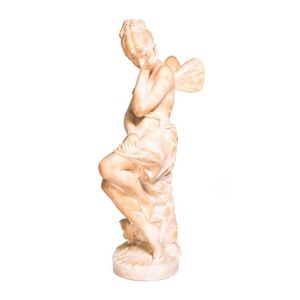Japanese Ivory Okimono: Seated Man with Branch and Knife
You must be a subscriber, and be logged in to view price and dealer details.
Subscribe Now to view actual auction price for this item
When you subscribe, you have the option of setting the currency in which to display prices to $Au, $US, $NZ or Stg.
- Ivory - Ivory is a hard white material that comes from the tusks of elephants, mammoth, walrus and boar, or from the teeth of hippopotamus and whales. The ivory from the African elephant is the most prized source of ivory. Although the mammoth is extinct, tusks are still being unearthed in Russia and offered for sale.
Ivory has been used since the earliest times as a material for sculpture of small items, both in Europe and the east, principally China and Japan.
In Asia ivory has been carved for netsuke, seals, okimono, card cases, fan supports, animals and other figures and even as carved tusks.
In the last 200 years in Europe ivory has been used to carve figures, for elaborate tankards, snuff boxes, cane handles, embroidery and sewing accessories, in jewellery and as inlay on furniture. Its more practical uses include being used for billiard balls, buttons, and a veneers on the top of piano keys.
The use and trade of elephant ivory have become controversial because they have contributed to Due to the decline in elephant populations because of the trade in ivory, the Asian elephant was placed on Appendix One of the Convention on International Trade in Endangered Species (CITES), in 1975, and in January 1990, the African elephant was similarly listed. Under Appendix One, international trade in Asian or African elephant ivory between member countries is forbidden. Unlike trade in elephant tusks, trade in mammoth tusks is legal.
Since the invention of plastics, there have been many attempts to create an artificial ivory - Incised - A record of a name, date or inscription, or a decoration scratched into a surface, usually of a glass or ceramic item with a blunt instrument to make a coarse indentation. Compare with engraving where the surface is cut with a sharp instrument such as a metal needle or rotating tool to achieve a fine indentation.
This item has been included into following indexes:
Visually similar items

A Victorian Parian figurine, a female goat herder seated on a rocky outcrop with a goat in her lap. Impressed to the side 'Art Union of Great Britain', some damage. Height 35 cm

Cesare Lapini (Florence, Italy, 1848-1893), A carved marble figure of Psyche, 88 cm high

Di Lifeng (China, b. 1958), Girl Oil on canvas, framed Signed Di Lifeng Undated 79.3 cm x 99.4 cm. Provenance: Private collection NSW, purchased in an art gallery in the World Trade Centre in Beijing in 1995

A Minton parian ware figure of 'Clorinda', after the model by John bell (1812-1895), 1848, with inscribed mark of John bell and date, February 1848; pattern 203, the weary figure of Clorinda the pagan warrior in battle dress, her helmet and gloves at her f
